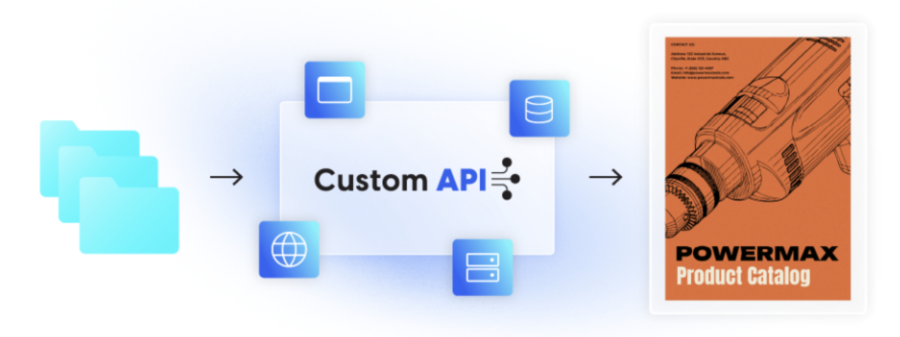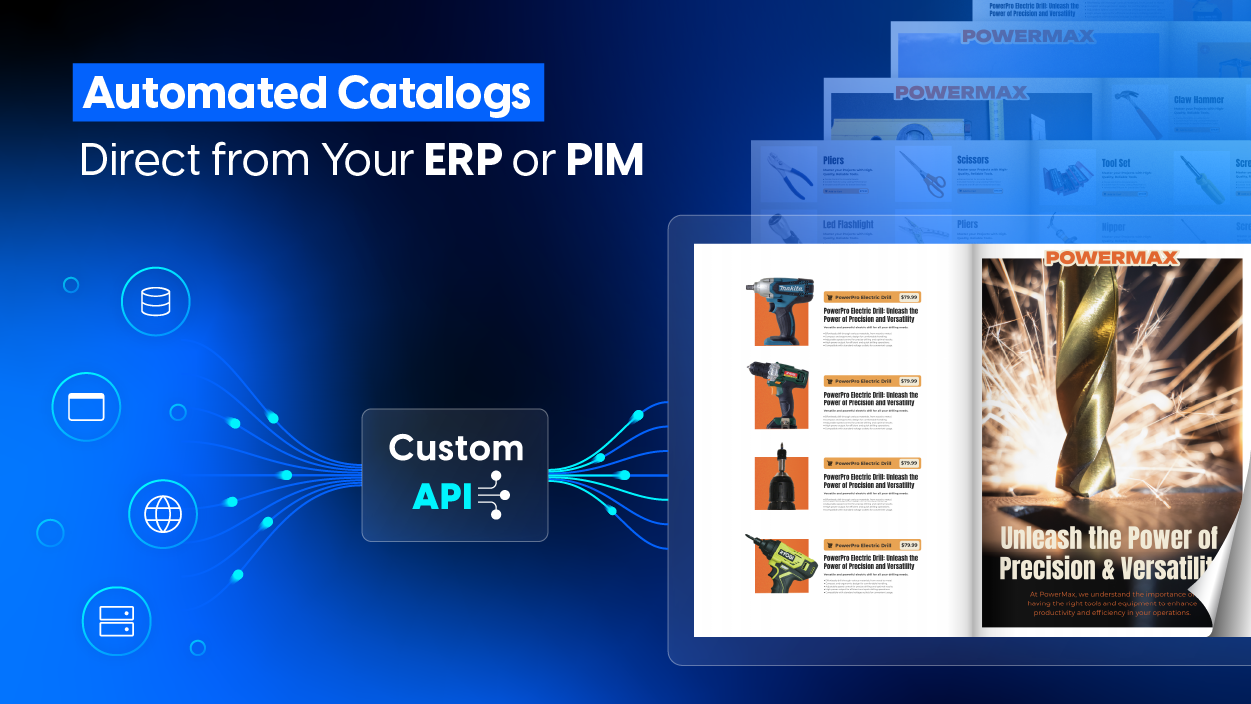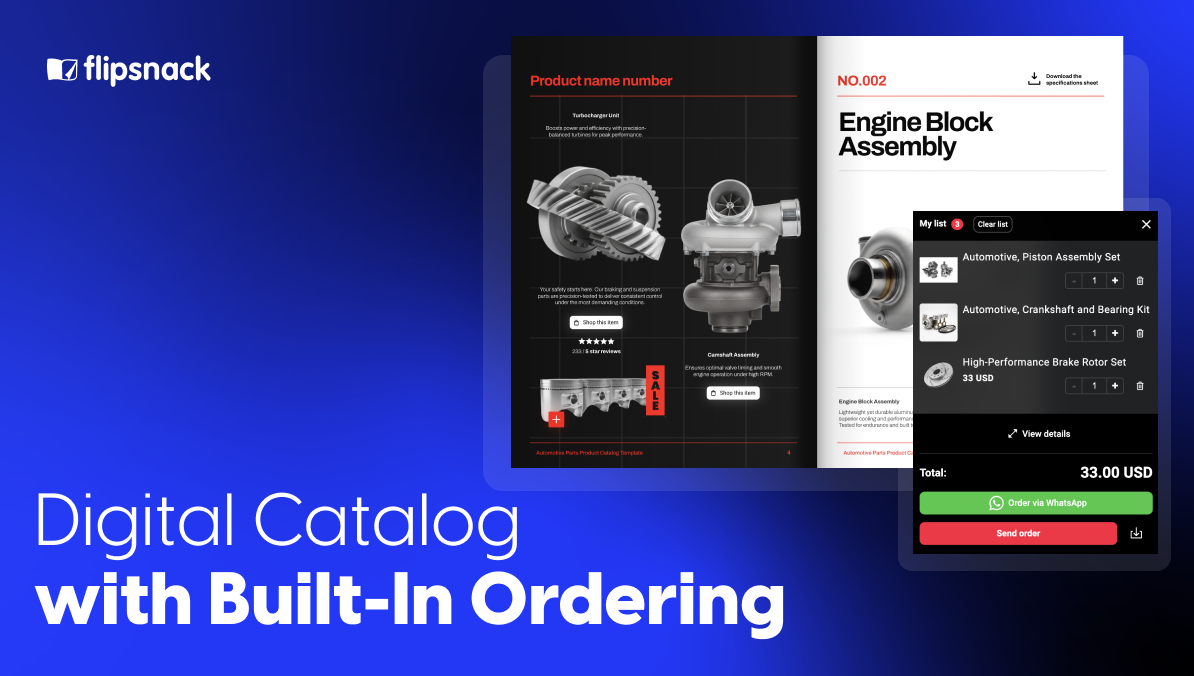From PIM Data to Digital Catalogs: Automate Your Workflow with Flipsnack
If you’re in wholesale, manufacturing, or retail, chances are you already use a PIM or ERP system to manage your product data. The problem? Turning that data into customer-ready catalogs is often slow, error-prone, and painfully manual.
Your product information is structured and centralized in your system, yet the moment you need a catalog, you’re stuck exporting spreadsheets, updating InDesign files, or chasing designers to fix prices and SKUs. By the time the catalog goes live, it’s already outdated.
This is exactly why businesses are looking for PIM to catalog integration and ERP catalog automation, a way to connect their product systems directly to a digital publishing platform like Flipsnack. You can generate catalogs straight from your PIM or ERP data, keeping your catalogs always accurate, up to date, and ready to publish.

Why creating manual catalogs doesn’t work anymore
If you’re a marketing or channel manager in a catalog-heavy industry, you’ve probably felt the pressure:
- Frequent updates – Product specs, prices, and SKUs shift constantly, and every change forces your team back into spreadsheets, InDesign, or PDFs.
- Inefficient workflows – Manually uploading data and fixing layouts can take hours or even days before catalogs are ready to share.
- High risk of errors – Outdated details or mismatched content not only frustrate sales teams but also damage customer trust.
The reality is, most teams already know they need to automate more and move faster. But simply adding another design tool won’t solve the root problem. What’s needed is automated product catalog software that connects directly to your ERP or PIM system, so catalogs update themselves using the data you already manage.
This is exactly where Flipsnack comes in. Flipsnack is a digital publishing platform built for businesses that rely on catalogs, brochures, and product marketing materials.
It enables companies in wholesale, manufacturing, and retail to design and publish professional, interactive flipbooks, digital catalogs that replicate the page-turning experience, but with the added benefits of interactivity, shareability, and analytics.
These online catalogs are easy to update, distribute, and track, and can be embedded directly on your website or shared as a link, making them instantly accessible to customers and partners. And with automation features, you can do all this without relying on endless design edits or costly print runs.
Simplify catalog creation with Flipsnack’s API
This is where Flipsnack makes a real difference. Instead of juggling two separate tools: your ERP or PIM system for managing product data, and a design platform for building catalogs, you can connect them directly through Flipsnack.
With Flipsnack’s Catalog API, we take it one step further. The API bridges the gap between your product database and your marketing catalogs, allowing product information to flow seamlessly from your ERP or PIM system into your digital catalogs.
Think of it as a bridge: on one side, you already have structured product data SKUs, descriptions, prices, and images managed in your ERP or PIM. On the other side, you need polished, customer-ready catalogs that can be published quickly and kept up to date.
With Flipsnack’s API, those two sides finally work together. Your product data flows directly into Flipsnack, where it becomes the foundation of your digital catalogs. That means no more wasted time on spreadsheets, manual uploads, or chasing down the latest specs. Instead, you get a direct path to API-based product catalog making: faster, more accurate, and scalable for any team.
With Flipsnack, you can:
- Generate catalogs from PIM data automatically—no spreadsheets, no manual uploads.
- Streamline your ERP to digital catalog workflow, so every update goes live instantly.
- Reduce catalog errors by syncing directly from your single source of truth.
- Scale B2B catalog generation across teams, regions, and product lines with minimal effort.
It’s the simplest way to achieve digital product catalog automation while working with the systems you already have.
How It Works
Flipsnack’s Catalog API was built with real-world catalog needs in mind. It gives you full control over your product data with three key actions:
- products.create – Import new products directly from your ERP or PIM into Flipsnack.
- products.update – Keep existing products accurate by syncing changes instantly.
- products.delete – Remove outdated items automatically, so your catalogs never show the wrong SKUs.
Here’s how the workflow looks in practice:

1. Push from ERP or PIM system
Your system sends product data SKUs, prices, images, and descriptions directly into Flipsnack using the API.
2. Product Sync in Flipsnack
The API validates the information and stores it in your Automation tab. Whether it’s a new product, an update, or a removal, everything stays in sync with your source system.
3. Build Faster Catalogs
Inside Design Studio, your updated product data is ready to drag and drop into catalog layouts. From there, you can publish interactive, digital catalogs instantly, always accurate, always current.
By connecting your PIM data to catalog integration directly to Flipsnack, you move from manual design to automated catalog publishing, faster, more accurate, and built to scale.

FAQ about PIM/ERP integration
The best tools are those that connect directly to your ERP via API-based product catalog generation. Flipsnack is one of the most efficient solutions, allowing you to sync ERP product data directly into interactive digital catalogs. This avoids manual uploads, keeps information accurate, and supports real-time updates.
To create a digital catalog from your PIM, you need a platform like Flipsnack that supports PIM to catalog integration. Once connected, your product information (SKUs, descriptions, images, pricing) flows seamlessly into Flipsnack, where you can design and publish catalogs instantly.
Yes. With tools like Flipsnack’s Catalog API, you can automate catalog creation directly from your ERP database. Every time product data changes in your ERP, the updates sync to Flipsnack, keeping your catalogs accurate and up to date.
The best way is through an API connection. Instead of exporting CSVs or copying data manually, your ERP or PIM system pushes product data into your catalog tool. In Flipsnack, this means instant sync via products. create, products.update, and products. delete API calls.
Not all catalog tools support API connections. Flipsnack is designed for this: it connects with ERP, PIM, or custom databases to automate catalog publishing. This makes it ideal for wholesalers, retailers, and manufacturers with large product inventories.
Choose a platform with PIM integration. In Flipsnack, your PIM pushes product data (SKUs, images, descriptions) into the Automation tab, where it’s ready to drag and drop into catalogs, no spreadsheets or manual editing required.
The easiest way is to use automated product catalog software like Flipsnack. You connect your ERP or PIM, sync product data, and then use Flipsnack’s Design Studio to create interactive catalogs with videos, links, and shopping options.
With Flipsnack’s ERP to digital catalog workflow, you can push real-time updates from your ERP into your catalogs. New products, price changes, or stock updates can appear instantly in published catalogs.
Absolutely. Flipsnack supports PIM integration for catalog publishing, so your structured product data flows directly into digital catalogs without manual work. This ensures accuracy and faster production cycles.
Flipsnack’s Catalog API eliminates manual editing by syncing directly with your ERP or PIM. Updates are automated, so your catalogs always reflect the latest product information.



